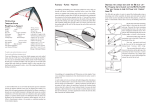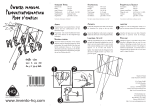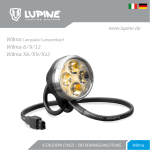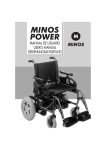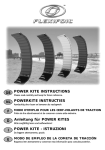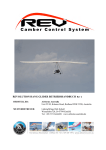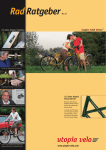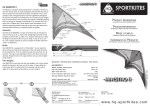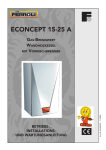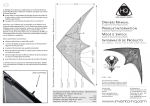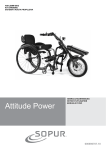Download Owners manual · Produktinformation Mode d emploi `
Transcript
Owners manual · Produktinformation Mode d' emploi Specifikation Technische Daten Description du Prodouct Wingspan/Spannweite/Envergure: Height/Standhöhe/Taille: Weight/Gewicht/Poids: Rec. line/empf. Schnur/Lignes conseillées: Wind range/Windbereich/Plage de vent: Sail fabric/Segelmaterial/Voilure: Leading Edge/Leitkante/Bord d'attaque: Top spreader/obere Spreize/Traverse avant: Bot. spreader/unt. Spreize/Traverse arrière: keel/Kielstab/Barre de quiell: The right to make technical alterations is reserved! Technische Änderungen vorbehalten! Tous droits de modifications techniques réservés 224 cm 123 cm 300 g 20-40 m, 30-100 kp 2-5 Bft. TM VENTEX G-Force Super Duper Skinny 6mm Avia carbon G-Force UL 6mm Avia carbon Design: Christoph Fokken The new Tramontana 2001 is the logical follow-up to HQ’s classic. You have acquired a top-class kite that leaves nothing to be desired. The successful competitive pilot André Babik played a substantial role in the development of the 2001. The kite owes much of its balanced flight behavior, tracking, precision, moderate speed and last but not least unlimited tricks to his experience. These make this kite a competition kite for single pilots as well as for pairs and teams. But even the ambitious hobby flyer will enjoy this kite. It flies over a wide wind range and thus can be used many different ways. The Tramontana 2001 loves when you play with it and forgives many steering errors and rough landings. You can find more information on this product on our support site on the Internet! Der neue Tramontana 2001 ist die konsequente Weiterentwicklung des Klassikers aus dem Hause HQ. Mit ihm haben sie ein Sportgerät der Extraklasse erworben, das keine Wünsche offen läßt. Der erfolgreiche Wettbewerbspilot André Babik war massgeblich an der Entwicklung des 2001 beteidigt. Seiner Erfahrung verdankt der Drachen sein ausgewogenes Flugverhalten, seine Spurtreue, seine Präzision, seine moderate Geschwindigkeit und nicht zuletzt seine uneingeschränkte Trickfähigkeit. Das macht den Drachen zu einem Wettkampfdrachen für den Einzelpiloten ebenso wie für Pairs und Teams. Aber auch der ambitionierte Freizeitflieger wird an diesem Drachen seine Freude haben, fliegt er doch über einen weiten Windbereich und ist damit vielseitig einsetzbar. Der Tramontana 2001 liebt es, wenn man mit ihm spielt, er verzeiht so manchen Lenkfehler und unsanfte Landungen. Weitere Daten zu diesem Produkt finden Sie auf unseren Supportseiten im Internet! Le nouveau Tramontana 2001 représente une évolution conséquente du classique de la maison HQ. En achetant ce cerf-volant, vous avez choisi un modèle hors normes qui répondra à toutes vos attentes. André Babik, le champion de réputation mondiale, a activement participé à la conception du 2001, l'excellent comportement en vol du cerf-volant, sa stabilité, sa précision, sa vitesse modérée, sans oublier sa capacité illimitée à exécuter des figures sont dus à son expérience de la compétition. Toutes ces qualités font du Tramontana un cerf-volant de compétition idéal, tant pour le vol en individuel qu'en paire ou en team. Les amateurs avertis apprécieront énormément sa grande fenêtre de vol et son caractère polyvalent. Le Tramontana 2001 adore que l'on joue avec lui et pardonne les erreurs de pilotage et les atterrissages rudes. Vous trouverez de plus amples informations concernant cet article sur notre site Internet ! Assembly and flying · Zusammenbau und Flug Montage et premier vol If your kite is folded, i.e. the rod in the leading edge is in two pieces, assemble it like this: Unfold the kite so that the leading edge is straight. Now carefully insert the bottom rod in the leading edge into the bushing of the top leading edge rod. Figure A shows this using an outer bushing, figure B shows this an inner bushing. Ist Ihr Drachen gefaltet, d.h. der Stab in der Leitkante ist geteilt, verfahren Sie wie folgt: Falten Sie den Drachen auseinander. Die Leitkante liegt nun gerade. Schieben Sie den unteren Stab in der Leitkante vorsichtig in die Muffe des oberen Leitkantenstabes. Die Abb. A zeigt die Verwendung einer Außenmuffe, die Abb. B zeigt das Schema einer Innenmuffe. Si votre cerf-volant est plié, cela signifie que la barre du bord d'attaque est en deux parties, procédez comme suit: dépliez le cerf-volant. Le bord d'attaque est désormais droit. Placez prudemment la barre inférieure dans le manchon de la barre supérieure du bord d'attaque. Le croquis A montre l'utilisation d'un raccord externe, le croquis B indique le schéma d'un raccord interne. Spreading the leading edge with the HQ split cap Das Spannen der Leitkante mit der HQ-Splittkappe Mise sous tension du bord d'attaque avec l'embout fendu HQ The HQ split cap makes it easier to spread the leading edge using a tensioning cord. After assembly, the knots and cord ends are tucked away inside recesses specially provided for this purpose, so that you achieve a clean finish. There's also a neat way of attaching a trick cord here. Step 1: Pull the short tensioning cord through the hole in the cap so that knot 1 disappears inside the recess. Now put the other end through the knot on the leading edge, as shown in the drawing. Step 2: Stretch the leading edge with the tensioning cord so that knot 2 locks into the bottom of the slot. Die HQ-Splittkappe erleichtert das Spannen der Leitkante mittels Spannschnur. Knoten und überstehende Schnurenden verschwinden nach der Montage in speziell angebrachten Vertiefungen, so daß ein sauberes Finish entsteht. Auch das Anbringen einer Trickschnur findet eine saubere Lösung. Schritt 1: Ziehen Sie die kurze Spannschnur so durch das Loch in der Kappe, daß der Knoten 1 in der Vertiefung verschwindet. Das andere Ende fädeln Sie wie gezeigt, durch die Schlaufe an der Leitkante. Schritt 2: Spannen Sie die Leitkante so mit der Spannschnur, daß sich der Knoten 2 in der Vertiefung des Schlitzes festsetzen kann. L'embout fendu HQ facilite la mise sous tension du bord d'attaque avec le fil de jonglage. Les nœuds et les bouts de ligne disparaissent après l'assemblage dans les creux prévus à cet effet, ce qui améliore considérablement la finition du travail. Il en est de même pour la fixation du fil de jonglage. 1ère étape: Faites ensuite passer la ligne de jonglage courte dans l'embout à travers le trou de manière à ce que le nœud 1 disparaisse dans le creux. Passez l'autre extrémité de la ligne à travers la boucle du bord d'attaque comme l'indique l'illustration. 2ème étape: tendez le bord d'attaque avec la ligne de jonglage de manière à ce que le nœud 2 se fixe dans le creux de la fente. Extending the wingtips · Aufspannen der Flügelspitze Montage des bouts d'ailes Simply bend the spars on the wingtips into the small pockets on the winglets. (See illustration) When the kite is not in use, the one end of the thin spar stays in the opening on the wing pocket (leading edge). This makes it practically impossible to lose the thin little rod! Die Segellatten an an den Flügelspitzen werden einfach in die kleinen Taschen an den Winglets gebogen. (Abbildung) Wenn der Drachen nicht gebraucht wird, verbleibt das eine Ende der dünnen Segellatten in der Öffnung an der Flügeltasche (Leitkante). So können Sie die dünnen Stäbchen praktisch nicht verlieren! Enfoncez les whiskers des bouts d'ailes dans les fourreaux en dacron (voir illustration). Lorsque vous n'utilisez pas le cerf-volant, l'une des extrémités du whiskers reste dans le fourreau du bord d'attaque. Ainsi, il est pratiquement impossible de perdre le whiskers ! The turbo bridle · Die Turbo-Waage · Le bridage turbo The turbo bridle is a dynamic bridle system that permits additional settings beyond those possible with a standard bridle. It allows you to modify the setting angle of the kite in a loop and - within certain limits - adapt to different wind speeds. The kite has a flatter setting angle when you fly it straight than when you fly curving flight paths. This makes it possible to fly loops very tightly, which is important especially at the edge of the wind window. As with a standard bridle, you can adjust the setting angle of the kite to trim it to various wind conditions. To do this loosen the knot A on the outer, uninterrupted bridle line and in light winds slide it towards the nose. (This makes the setting angle flatter). In strong winds slide it towards the wing tip (making the setting angle steeper). If the kite "overpowers" in strong wind, i.e. if it flies with a jerky motion and the wing tips flap, you can reduce the pressure on the kite by shortening the upper bridle leg again - in other words, slide the knot A towards the nose. But remember to note the wind range specified for the kite! Adjusting the connection loops (knot B) mainly changes the turning behaviour of the kite. If you move them outwards you achieve larger and slower spins, while if you move them inwards the spins become smaller and faster. If your kite does not stop turning soon enough, you can counteract this by shifting the connection point (knot B) outwards or by shifting the knot A towards the kite nose. The additional, middle bridle line adds extra stabilization to the leading edge. Be sure that this line sags slightly. When adjusting the bridle, this line may have to be lengthened or shortened. Simply move the knob in the desired direction. It will block itself under load. Die Turbowaage ist ein dynamisches Waagesystem und bietet gegenüber der Standardwaage zusätzliche Einstellmöglichkeiten. Sie ermöglicht es den Anstellwinkel des Drachens im Loop zu verändern, und paßt sich – innerhalb bestimmter Grenzen – unterschiedlichen Windgeschwindigkeiten an. Der Drachen hat im Geradeausflug einen flacheren Anstellwinkel als im Kurvenflug. Loops können dadurch sehr eng geflogen werden, was besonders am Windfensterrand wichtig ist. Wie bei einer Standardwaage auch, kann man den Anstellwinkel des Drachens einstellen, um ihn auf verschiedene Windverhältnisse zu trimmen. Dazu lösen Sie den Knoten A auf der äußeren durchgehenden Waageleine und schieben ihn bei wenig Wind in Richtung Nase (der Anstellwinkel wird flacher) oder bei viel Wind in Richtung Flügelspitze (der Anstellwinkel wird steiler). Sollte der Drachen bei viel Wind "überpowern", d.h. er neigt zum Ruckeln und die Flügelspitzen schlagen, können Sie den Druck des Drachens reduzieren, indem Sie den oberen Waageschenkel wieder verkürzen – also den Knoten A in Richtung Nase schieben. Beachten Sie dennoch den für den Drachen angegebenen Windbereich! Eine Verstellung des Anknüpfschlaufe (Knoten B) verändert in erster Linie das Drehverhalten. Weiter nach außen: größere und langsamere Spins; weiter nach innen: kleinere und schnellere Spins. Sollte Ihr Drachen zu stark nachdrehen, können Sie diesem durch das Verschieben des Anknüpfpunktes (Knoten B) nach außen oder durch Verschieben des Knotens A in Richtung Drachennase entgegenwirken. Der zusätzliche, mittlere Waageschenkel dient der zusätzlichen Stabilisierung der Leitkante. Bitte achten Sie darauf, dass dieser Schenkel leicht durchhängt. Bei Verstellung der Waage kann es passieren, dass diese Schnur verlängert oder verkürzt werden muß. Dazu verschieben Sie einfach den Knoten entsprechend, er wird sich unter Last blockieren. Le bridage turbo est un système de bridage dynamique permettant des réglages supplémentaires par rapport au bridage classique. Il permet entre autre de modifier l'angle d'incidence dans le virage et s'adapte dans une certaine limite à différentes forces de vent. Le cerf-volant a un angle d'incidence plus plat en vol droit que dans les virages. Ceci permet de prendre les virages plus serrés, ce qui est particulièrement important sur les bords de la fenêtre de vol. Tout comme dans le cas d'un bridage classique, il est également possible de modifier l'angle d'incidence du cerf-volant pour l'adapter aux différentes forces de vent. Desserrez le nœud central (A) sur la bride externe et remontez-le (max. 1,5 cm) vers le nez si le vent est faible (vous réduisez l'angle d'attaque) ou vers le bout de l'aile si le vent est fort (vous augmentez l'angle d'attaque). Si le cerf-volant a trop de traction par vent fort, c-a-d qu'il tend à vibrer et que les pointes des ailes battent, réduisez la traction en remontant le nœud central vers le nez. N'oubliez pas de tenir compte de la plage de vent recommandée pour le cerf-volant. Le réglage des points d'attache (B) permet de modifier le comportement dans les virages. Déplacez le nœud vers l'extérieur pour décrire des virages plus lents et plus grands; déplacez-le vers l'intérieur pour décrire des virages plus rapides et plus petits. Si votre cerf-volant a trop tendance à survirer, déplacez les deux points d'attache (B) vers l'extérieur ou remontez le nœud A vers le nez. Le 3ème noeud de bride central assure la stabilisation supplémentaire du bord d'attaque. Assurez-vous que ce nœud de bride n'est pas tendu. Lorsque vous réglez le bridage, il peut s'avérer nécessaire de rallonger ou de raccourcir ce fil. Pour ce faire, déplacez simplement le noeud selon vos besoins, il se bloquera automatiquement lorsqu'il sera sollicité. A B Owners manual Produktinformation Mode d ' emploi Made in Poland under license by InVento © In Vento GmbH D-26180 Rastede Germany Service: (04402) 926244 e-mail: [email protected] http://www.invento-hq.com US Distribution by: Nova Design Group West Hurley, NY 12491 Phone: (914)3310977 http://www.novadesigngroup.com High Performance InVento GmbH D 26180 Rastede Germany www.invento-hq.com



